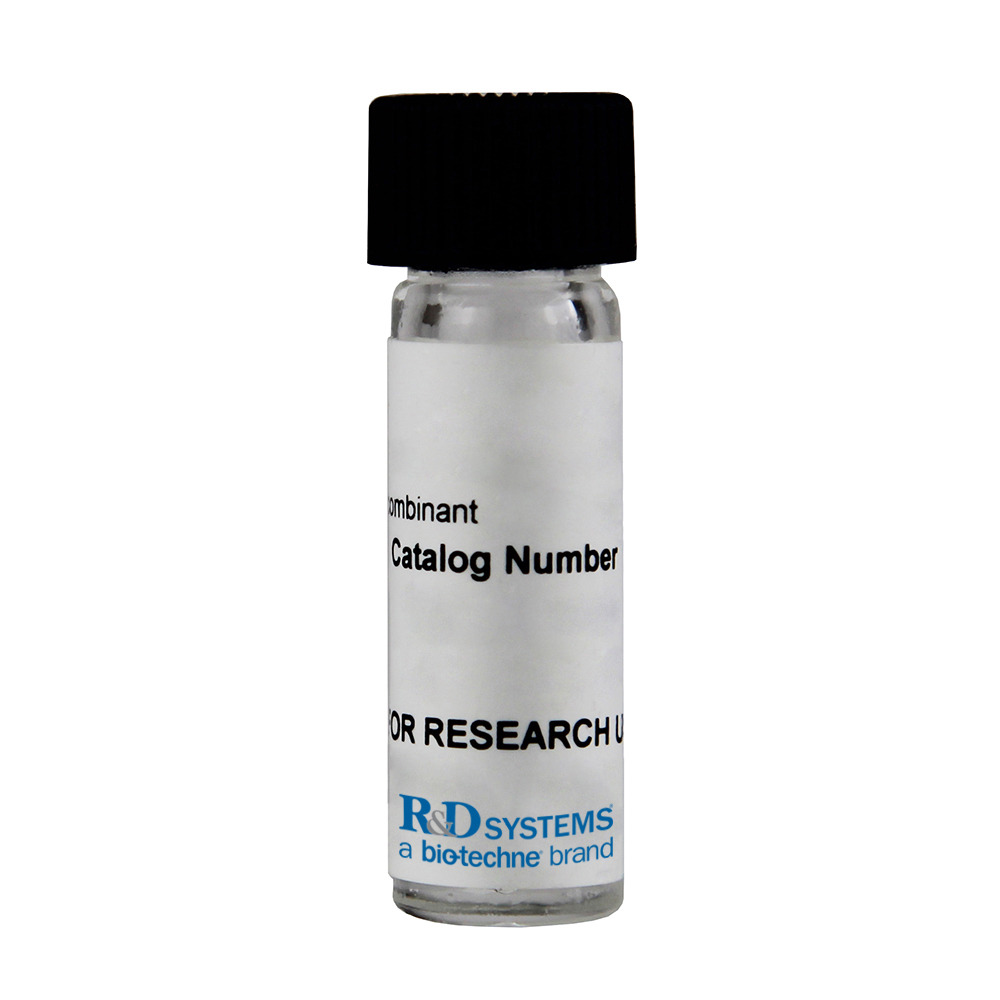

 下载产品说明书
下载产品说明书 下载SDS
下载SDS 用小程序,查商品更便捷
用小程序,查商品更便捷



 收藏
收藏
 对比
对比 咨询
咨询Carrier Free
CF stands for Carrier Free (CF). We typically add Bovine Serum Albumin (BSA) as a carrier protein to our recombinant proteins. Adding a carrier protein enhances protein stability, increases shelf-life, and allows the recombinant protein to be stored at a more dilute concentration. The carrier free version does not contain BSA.
In general, we advise purchasing the recombinant protein with BSA for use in cell or tissue culture, or as an ELISA standard. In contrast, the carrier free protein is recommended for applications, in which the presence of BSA could interfere.
2535-MM
| Formulation | Lyophilized from a 0.2 μm filtered solution in PBS with BSA as a carrier protein. |
| Reconstitution | Reconstitute at 100 μg/mL in sterile PBS. |
| Shipping | The product is shipped at ambient temperature. Upon receipt, store it immediately at the temperature recommended below. |
| Stability & Storage: | Use a manual defrost freezer and avoid repeated freeze-thaw cycles.
|
2535-MM/CF
| Formulation | Lyophilized from a 0.2 μm filtered solution in PBS. |
| Reconstitution | Reconstitute at 100 μg/mL in sterile PBS. |
| Shipping | The product is shipped at ambient temperature. Upon receipt, store it immediately at the temperature recommended below. |
| Stability & Storage: | Use a manual defrost freezer and avoid repeated freeze-thaw cycles.
|
Recombinant Mouse MMR/CD206 Protein Summary
Product Specifications
Leu19-Ala1388, with a C-terminal 6-His tag
Analysis
Background: MMR/CD206
The MMR (macrophage mannose receptor) is also called MR due to its presence on cells other than macrophages, and is designated CD206, Mrc1 (mannose receptor C type 1), or CLEC13D (C‑type lectin domain family 13, member D) (1‑4). CD206 is a 175 kDa endocytic receptor that is expressed on M2 alternatively activated tissue macrophages including tumor‑associated macrophages (TAMs), inflammatory dendritic cells in selected lymphoid organs, and liver, splenic, lymphatic, and dermal microvascular endothelial cells (1, 2, 5‑8). The 1456 amino acid (aa) mouse CD206 precursor contains a signal sequence (19 aa), an extracellular domain (ECD) containing an N‑terminal cysteine‑rich domain, a fibronectin type II repeat, eight C‑type lectin domains (CTLDs), and several N‑glycosylation sites (1369 aa), a transmembrane segment and a short (47 aa) cytoplasmic domain (2‑4). Metalloproteinases can mediate the shedding of the soluble ECD (2). The mouse CD206 ECD shares 96% aa sequence identity with rat MR, and 83‑84% with human, equine, porcine and canine CD206. The cysteine-rich domain recognizes some pituitary hormones such as LH (luteinizing hormone/lutropin) and TSH (thyroid stimulating hormone/thyrotropin), chondroitin sulfates, and sulfated N‑acetylgalactosamines including sulfo‑Lewisa and ‑Lewisx (1, 7, 9). The FNII domain mediates Ca2+‑independent binding of collagens (2, 10). The CTLDs participate in Ca2+‑dependent recognition of branched sugars with terminal mannose, fucose or N‑acetylglucosamine that occur on many pathogenic microorganisms (7, 11). CD206 internalizes ligands in clathrin-coated vesicles, sorts them to phagosomes or early endosomes, and recycles to the cell surface (1, 6, 7). CD206 also promotes clearance of glycoproteins that promote allergy or ongoing inflammation, such as lysosomal hydrolases and myeloperoxidases (1, 2, 5‑7). It is involved in T cell polarization and production of pro‑ and anti‑inflammatory cytokines (1, 2). It facilitates peptide presentation on MHC II, and cross‑presentation on MHC I which is important for tumor immunogenicity (1, 2, 12). This function may be blocked by engagement of CD206 on TAMs by tumor mucins (8).
- Gazi, U. and L. Martinez-Pomares (2009) Immunobiology 214:554.
- Martinez-Pomares, L. (2012) J. Leukoc. Biol. 92:1177.
- Harris, N. et al. (1992) Blood 80:2363.
- Taylor, M.E. et al. (1990) J. Biol. Chem. 265:12156.
- Chieppa, M. et al. (2003) J. Immunol. 171:4552.
- Figdor, C. et al. (2002) Nat. Rev. Immunol. 2:77.
- Taylor, P.R. et al. (2005) Trends Immunol. 26:104.
- Allavena, P. et al. (2010) Clin. Dev. Immunol. 2010:547179.
- Leteux, C. et al. (2000) J. Exp. Med. 191:1117.
- Martinez-Pomares, L. et al. (2006) Eur. J. Immunol. 36:1074.
- Taylor, M.E. et al. (1992) J. Biol. Chem. 267:1719.
- Singh S.K. et al. (2011) Eur. J. Immunol. 41:916.









 危险品化学品经营许可证(不带存储) 许可证编号:沪(杨)应急管危经许[2022]202944(QY)
危险品化学品经营许可证(不带存储) 许可证编号:沪(杨)应急管危经许[2022]202944(QY)  营业执照(三证合一)
营业执照(三证合一)